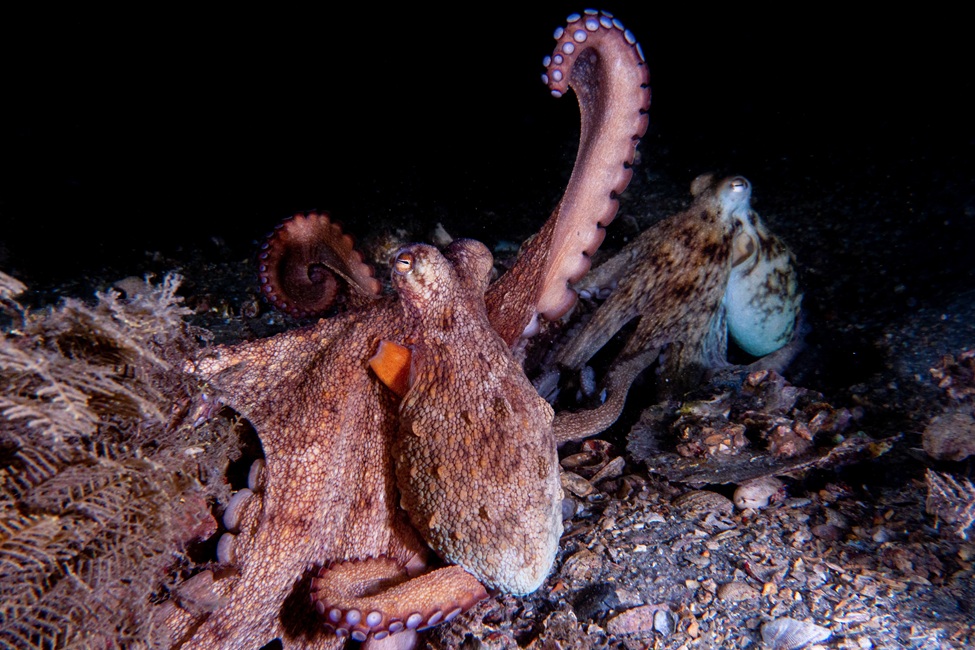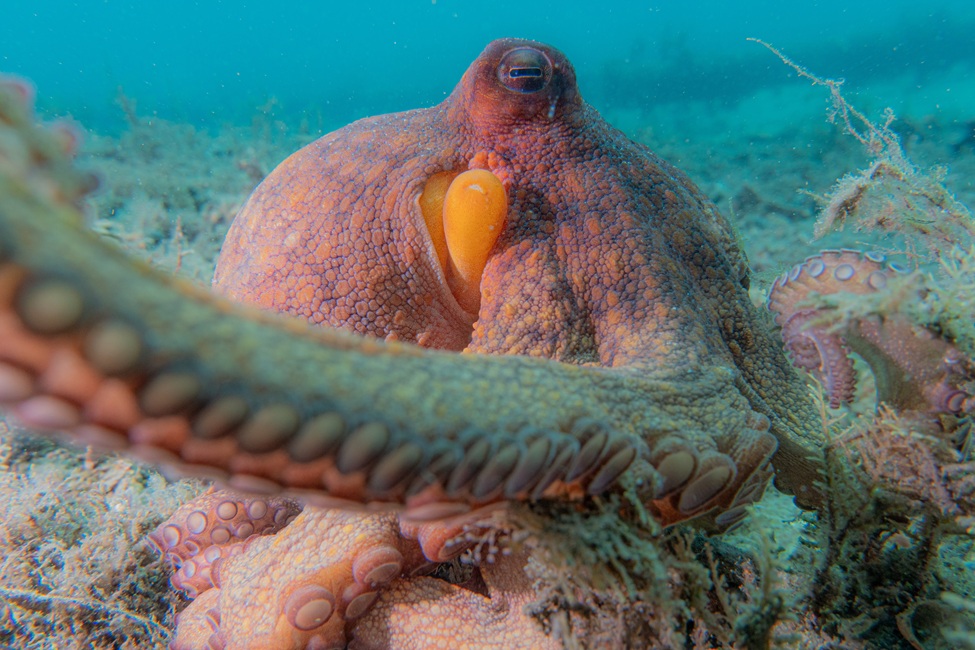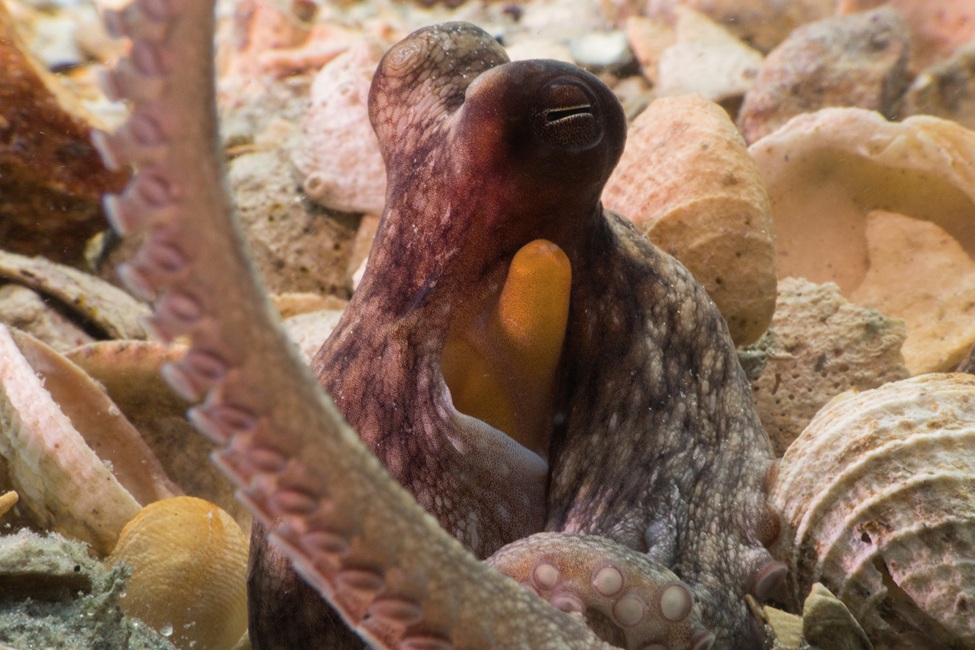Research Characterizes Remarkable Skills of Octopus Arms in the Wild

An octopus raises its arm. (Photo credit: Chelsea Bennice, Florida Atlantic University)
Octopuses are among the most neurologically complex invertebrates, famed for their extraordinary dexterity. Their eight arms allow them to capture hidden prey, communicate, explore, and even mate across varied habitats.
Although octopus arms rank among some of the most flexible structures in nature, their full range of movement has rarely been studied in the wild – especially in a range of underwater habitats.
A new study by Florida Atlantic University’s Charles E. Schmidt College of Science, in collaboration with researchers from the Marine Biological Laboratory in Woods Hole, Massachusetts, provides a comprehensive look into how wild octopuses use their arms in natural habitats. By analyzing arm movements across diverse environments, this is the first study to relate arm movements to whole animal behaviors in complex, real-world settings.
The findings, published this week in Scientific Reports, reveal that every arm is capable of performing all action types; however, there was a clear pattern of arm partitioning: front arms mainly use movements to aid in exploration, while back arms use movements that primarily support movement.
Additionally, the octopuses demonstrated remarkable flexibility – single arms were shown to perform multiple arm movements simultaneously and different arm movements were coordinated across several arms, showcasing their complex motor control.
“Observing them in the wild, we saw octopuses use different combinations of arm actions – sometimes just one arm for tasks like grabbing food, and other times multiple arms working together for behaviors like crawling or launching a parachute attack – a hunting technique they use to catch prey,” said Chelsea O. Bennice, Ph.D., lead author and a research fellow at FAU’s Marine Laboratory, Charles E. Schmidt College of Science.
Researchers quantified nearly 4,000 arm movements from 25 video recordings of three wild octopus species observed in six distinct shallow-water habitats – five located in the Caribbean and one in Spain. They identified 12 distinct arm actions across 15 behaviors, each involving one or more of four fundamental arm deformations: shortening (arm length decreases), elongating (arm length increases), bending (arm curves) and torsion (twisting).
“When octopuses move across an open environment, they skillfully use multiple arms to stay camouflaged from predators, such as the moving rock trick or looking like floating seaweed,” said Bennice. “Beyond foraging and locomotion, their arm strength and flexibility are essential for building dens, fending off predators, and competing with rival males during mating. These versatile abilities allow octopuses to thrive in a wide range of habitats.”
In the nearly 7,000 observed arm deformations, all four types – bend, elongate, shorten and torsion – were seen in every arm. However, different regions of each arm – proximal (closest to the body), medial (middle section) and distal (tip) – were found to specialize in specific types of arm deformation, reflecting a sophisticated level of functional specialization; bends mostly occurred near the tips, whereas elongations were more frequent closer to the body.
“I’m a strong believer that you have to get into the natural world, and especially the sensory world, of whatever animal you study,” said Roger Hanlon, Ph.D., co-author and senior scientist, Marine Biological Laboratory in Woods Hole. “The fieldwork is very arduous, and it takes a lot of luck to get valid natural behaviors.”
The six octopus habitats in this study varied from smooth, sandy seafloor to highly complex coral reef environments.
“Understanding these natural behaviors not only deepens our knowledge of octopus biology but also opens exciting new avenues in fields like neuroscience, animal behavior and even soft robotics inspired by these remarkable creatures,” said Bennice.
Study co-authors are Kendra C. Buresch, a marine biologist; Jennifer H. Grossman; an undergraduate student, and Tyla D. Morano, all with the Marine Biological Laboratory in Woods Hole.
This research was supported in part by the Sholley Foundation, the Ben-Veniste Family Foundation, and the United States Office of Naval Research.
//
Video credit: Chelsea Bennice, Florida Atlantic University and Roger Hanlon, Marine Biological Laboratory, Woods Hole

A common octopus in South Florida waters. (Photo credit: Chelsea Bennice, Florida Atlantic University)

An octopus Americanus. (Photo credit: Chelsea Bennice, Florida Atlantic University)
-FAU-
Latest Research
- FAU's Queen Conch Lab Receives Prestigious International AwardFAU Harbor Branch researchers have received the 2025 Responsible Seafood Innovation Award in Aquaculture from the Global Seafood Alliance for its Queen Conch Lab's pioneering work in sustainable aquaculture.
- After Cancer: Study Explores Caring-Healing Modalities for SurvivorsResearch from FAU's Christine E. Lynn College of Nursing highlights how caring-healing methods like mindfulness can ease distress and build resilience in cancer survivors.
- FAU Researchers 'Zoom' in for an Ultra-Magnified Peek at Shark SkinWhat gives shark skin its toughness and sleek glide? Tiny, tooth-like denticles. Researchers used electron microscopy to reveal how these structures shift with age, sex, and function in bonnethead sharks.
- FAU Lands $3M Federal Grant to Prevent Substance Use in At-risk Youth"Rising Strong" will support more than 3,000 South Florida youth with trauma-informed, evidence-based prevention, empowering vulnerable populations to build resilience and choose substance-free futures.
- FAU Research: Logistics Expansion Slows as Transportation Prices DropThe Logistics Managers' Index had the lowest overall reading since March as the supply chain reacts to economic uncertainty, according to researchers from Florida Atlantic University and four other schools.
- World's First Bench-to-Bedside MRI, Focused Ultrasound System UnveiledThe newly expanded FAU NeuroInnovate Center is the first in the world to integrate advanced MRI and focused ultrasound technologies into a single, unified platform for both preclinical and clinical research.






